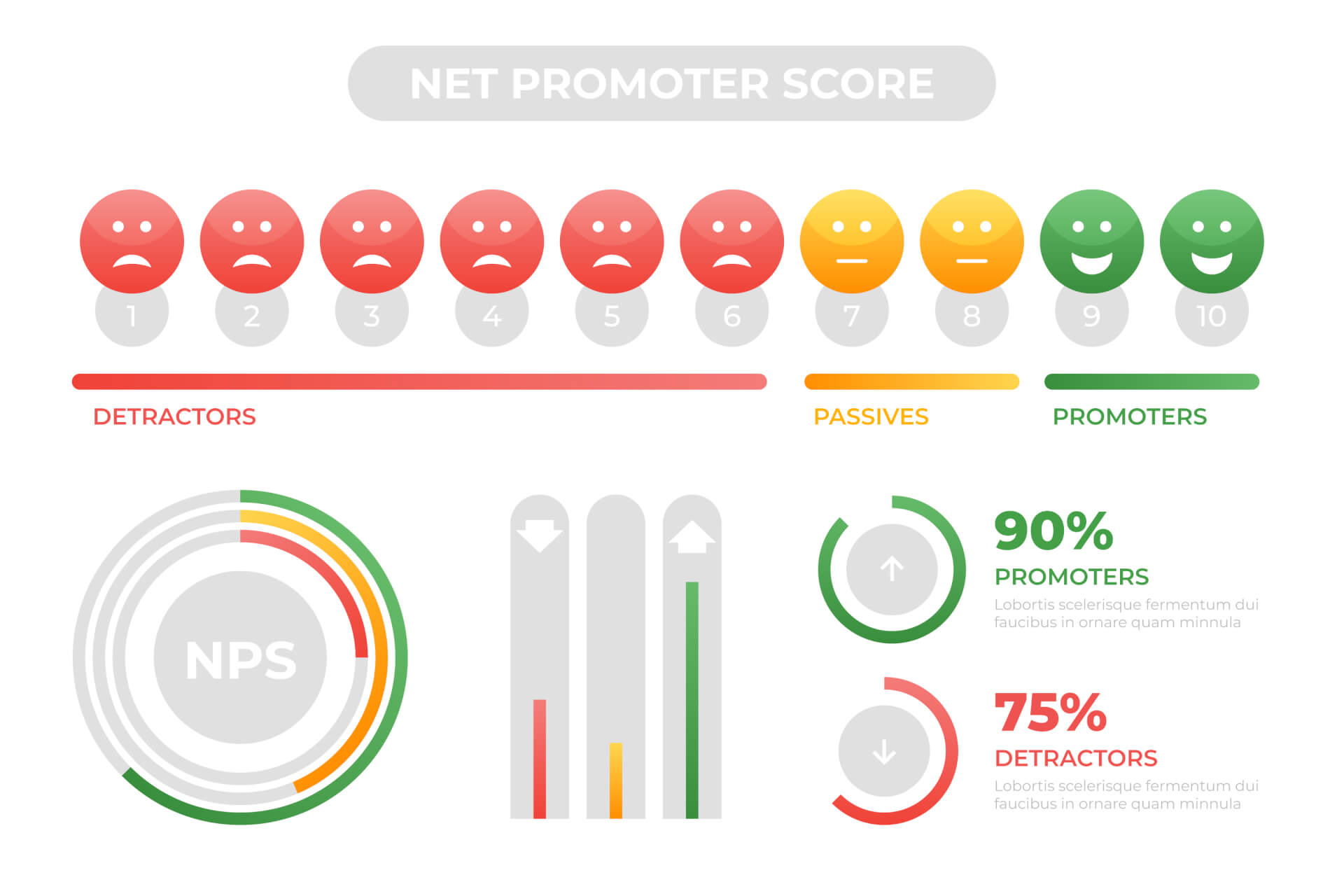Loyal and dedicated employees are critical to a company's ability not only to sell a product or service, but also to create brand ambassadors who promote it as a great place to work.
If you want to grow your business, you need happy and proactive people who constantly push the boundaries of what is necessary, deliver an exceptional customer experience, make informed decisions and come up with innovative ideas for the development of your company.
There is also plenty of solid evidence that happy employees translate directly into better performance and, therefore, higher profits. So it really pays to invest in the satisfaction of your employees.

Table of Contents
- The Employee Net Promoter Score®
- Application similar to classic NPS surveys
- Loyal and satisfied employees are more productive
- High job satisfaction leads to lower costs
- Satisfied employees stay with you longer
- Employee loyalty is linked to customer loyalty
- Satisfied employees mean better customer service.
- Track eNPS to increase employee satisfaction
- Conduct anonymous eNPS surveys with Callexa
The Employee Net Promoter Score®

The use of the Employee Net Promoter Score® or eNPS for short is becoming increasingly popular in various companies. But how is it used and how can you use it to increase employee satisfaction?
The Employee Net Promoter Score® (eNPS) is a derivative of the popular Net Promoter System Framework.
Originally a index to make customer satisfaction visible and to measure the likelihood that a customer will recommend the company to others, the NPS was later also used internally to survey employees in order to also measure their satisfaction and commitment.
Many companies have already recognized the importance of employees being promoters themselves, because only an employee who is truly convinced that the service he is selling is the best on the market can make the customer a promoter too.
Application similar to classic NPS surveys
The decisive advantage of this type of survey is that it basically only requires two to three questions, which means that the burden on the employee remains low.
Although many eNPS users have only been satisfied with one main question,
"On a scale from 0-10, how likely is it that you would recommend this company as an employer?"
were many other companies who found that a follow-up question produced even better results:
"What is the main reason for your score?"
This second “why” question triggers the real power of the eNPS survey. Employees can provide accurate, unbiased feedback in their own words without being constrained by pre-defined survey responses.
The Employee Net Promoter Score is then calculated by dividing the respondents into three categories based on their opinion of your company, similar to the classic NPS:
- 9-10 - Promoters: These are happy and loyal employees who love your company and have a very high probability of recommending it to friends and acquaintances.
- 7-8 - Passive: You are the one who has little enthusiasm for your company and probably won't recommend it to anyone.
- 0-6 - Critic: You are dissatisfied with the company and are likely to damage your brand reputation with negative word of mouth.
 To calculate your eNPS, you only have to subtract the percentage of critics from the percentage of promoters.
To calculate your eNPS, you only have to subtract the percentage of critics from the percentage of promoters.
eNPS = (% of promoters) - (% of critics)
After that, a positive or negative value remains between -100 and 100.
It is important to mention that the employees' Net Promoter Scores are usually significantly lower than the value you would get in a customer survey. Employees are severe critics and often place even higher demands on their company than customers do. So don't be surprised if your eNPS is lower than your NPS.
Loyal and satisfied employees are more productive
 Whether you're running a startup or a large company with thousands of employees, it's hard to ignore the fact that happy employees are doing everything they can to keep the company better.
Whether you're running a startup or a large company with thousands of employees, it's hard to ignore the fact that happy employees are doing everything they can to keep the company better.
A study by economists found that satisfaction led to a 12% increase in productivity, while dissatisfied workers were 10% less productive.
When employees feel connected to your brand, they develop creative and innovative ideas and go beyond their everyday tasks to achieve common goals.
Loyal and committed employees make better decisions, are characterized by excellent time management and have great self-motivation skills. In addition, happy employees are better leaders.
High job satisfaction leads to lower costs
 As mentioned earlier, loyal employees are more productive, which leads to higher profitability.
As mentioned earlier, loyal employees are more productive, which leads to higher profitability.
Studies have shown that companies with highly committed employees earn twice the annual net income compared to companies whose employees are lagging behind in engagement.
It is also interesting that money is not necessarily a motivating factor for committed employees. Of course, they have to be paid a decent salary, but the happiest and most dedicated employees feel like they are working for more than just money.
It's the intrinsic motivators that matter to them, things like the feeling of accomplishment, of doing the job to the best of their ability, or the sense of purpose, of accomplishing something of real value - something that matters in the bigger picture.
Well-executed eNPS surveys should be viewed as an investment, not an expense. The insights you get through them will prove invaluable in time.
Satisfied employees stay with you longer
Higher employee loyalty reduces employee turnover. Many companies spend a lot of time and money investigating the causes of the turnover rate due to the significant business cost of replacing employees.
On average, it costs about 20% of an employee's annual salary to replace them. For example, the cost of representing a person who earns EUR 50,000 per year would be EUR 10,000.
There are many factors that influence this including:
- Hiring costs, such as B. Advertising, Interviews and Recruitment;
- The cost of onboarding a new employee, including training and time management;
- Loss of Productivity: It can take 7-8 months for a new employee to reach the same level of productivity;
- Time expended for the vacant role;
- Customer satisfaction costs at risk from poor customer service.
To avoid these costs, you need to make sure you understand your employees' attitudes towards your company and continuously measure your eNPS to prevent them from leaving.
Employee loyalty is linked to customer loyalty

Imagine working as a customer service rep with lots of other people. You sit in a small office in low light every day, your manager is never grateful despite hard work and overtime, you are exhausted and nobody cares how you feel.
This is the face that represents the company and speaks to customers. And that's an unhappy face.
You can't please everyone, but of course you want your employees to be at their best when they are taking care of your business and customers.
To do this, you have to put yourself in their shoes. These are the people who work on or sell your product, and only if the employees are promoters themselves can turn a customer into a promoter too.
Satisfied employees mean better customer service.
73% of consumers would consider buying from a brand again if they had a great customer experience. Please note that customers who are enthusiastic about an excellent service are 10-30% more loyal than customers who were not enthusiastic.
Treat your employees the way you would like to be treated and value your employees as much as your customers. And not just because it leads to more productivity or profitability, but because this is the way to go.
Track eNPS to increase employee satisfaction
If you haven't already thought about implementing eNPS in your company, maybe you should. When implemented as part of an ongoing process, it can help team leaders identify, prioritize, and work on continuous improvement.
These surveys can be carried out in different employment phases of the workers, such as for example:
- Immediately after training, a course or advanced training
- As part of a performance review
- For the work anniversary
eNPS surveys provide quick feedback on what employees like and dislike about your company. These results are easy to interpret and serve as a useful predictor of growth.
When the feedback from eNPS surveys is shared with supervisors and team leaders, it leads to better team management and helps diversify product development strategies.
It also enables employee satisfaction tracking by office or department. This feature is especially valuable for large companies that have multiple offices around the world. By filtering this data, they can better understand what works and what doesn't for that particular department or office.
Overall, eNPS is a short and efficient survey that can help you break communication or organizational barriers and get honest, unbiased feedback.
Conduct anonymous eNPS surveys with Callexa
Dedicated and loyal employees lead to higher customer satisfaction, lower costs, more ideas and faster growth. eNPS is the tool you can use to measure employee satisfaction and take appropriate action to improve it.
However, there is one important thing to keep in mind with eNPS surveys: The survey should be anonymous.
While it is tempting to know the name of the disgruntled employee, only confidential responses will encourage honest feedback.
Callexa makes it easy for you to maintain the anonymity of your employees while getting the valuable feedback you need to recruit and retain your talent.
You can always ask the staff to expand their answers. When someone has a brilliant idea, give them an opportunity to provide details. If an employee leaves negative feedback, ask them why they are feeling this way and take appropriate action. Callexa allows you to adjust the follow-up questions accordingly to get the results you need.
 Reading recommendation: If this article helped you and you would like to find out more about the Net Promoter Score, continue reading here: “The Net Promoter Score – Basics and Areas of Application”
Reading recommendation: If this article helped you and you would like to find out more about the Net Promoter Score, continue reading here: “The Net Promoter Score – Basics and Areas of Application”